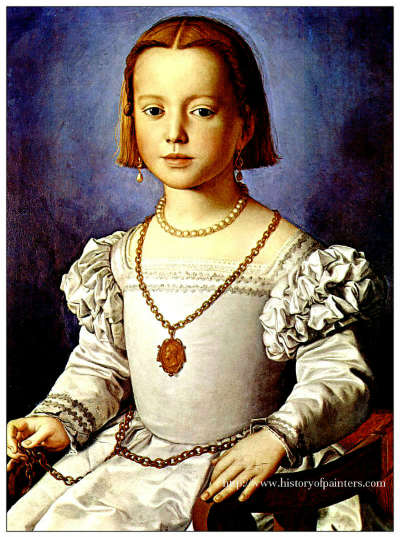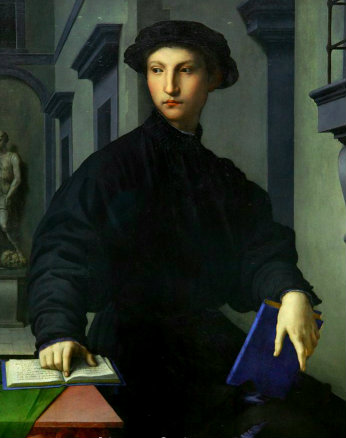100 Greatest Painters Artists Alphabetically Artists by Country Artists by Century Artists by Movement
Agnolo Bronzino
1503 - 1571
Florentine Mannerist Painter
Portrait of Bia de'Medici (illegitimate daughter of Cosimo). circa 1542 Galleria degli Uffizi, Florence, Italy.
Agnolo Bronzino Biography
Bronzino, Pontormo’s close follower, had none of his master’s talent as a decorator, but happily much of his power as a portrait-painter. Would he had never attempted anything else! The nude without material or spiritual significance, with no beauty of design or colour, the nude simply because it was the nude, was Bronzino’s ideal in composition, and the result is his “Christ in Limbo.” But as a portrait-painter, he took up the note struck by his master and continued it, leaving behind him a series of portraits which not only had their effect in determining the character of Court painting all over Europe, but, what is more to the point, a series of portraits most of which are works of art. As painting, it is true, they are hard, and often timid; but their air of distinction, their interpretive qualities, have not often been surpassed. In his Uffizi portraits of Eleanora di Toledo, of Prince Ferdinand, of the Princess Maria, we seem to see the prototypes of Velasquez’ queens, princes, and princesses: and for a fine example of dignified rendering of character, look in the Sala Baroccio of the Uffizi at a bust of a young woman with a missal in her hand.
Description of the Mannerist Style
Originating in Italy, the term mannerism comes from the Italian 'maniera', which translates to 'style'. Mannerism is an artistic style that was born in the early 1500s. The style originated in Italy and later widened to all of Europe. Mannerists paintings are characterized by elongated limbs, thin aquiline noses, long tapering fingers, undersized heads, garish colors and elaborately mannered, contorted postures. The Mannerists in Italy worked on commission for a restricted audience of Vatican powerbrokers and royalty. The subjects they were allowed to portray was controlled and restricted to Biblical themes, portraits and occasionally mythology. El Greco spurned the sumptuous commissions in favor of artistic freedom went off to Spain and to pursue his own magnificent vision.

Ugolino Martelli, circa 1537, Oil on wood
Symbolism in Art
☼☼☼☼☼
Important Words, People, Phrases, Characteristics related to the Italian Renaissance Art Movement - rebirth, rediscovery of the classical world, City-state, Humanism, Humanist, Francesco Petrarch, Reform, The Prince, Theocracy, The Inquisition, Human Reasoning, Medici Academy, publication of Della Pittura, a book about the laws of mathematical perspective for artists, sfumato, chiaroscuro, linear perspective, Heliocentric Theory, Petrarch, Baldassare Castiglione, The Book of the Courtier, liberal arts, civic humanism, Verrocchio, secularism, Leonardo Bruni, Lorenzo Valla, Neo-Platonism, nominalism, Giotto, Masaccio, Botticelli, Quattrocento, vanishing point, Savonarola, oligarchy spiritually significant, illuminated manuscript, idealized biblical themes, scriptorium, emotion, illuminator, iconoclast, Michelangelo and Leonardo Da Vinci, Age of Discovery, axonometric drawing, curiosity about the natural world, mythology, realistic use of colours and light, Bonfire of the Vanities, Old Testament stories, ethereal and foggy backgrounds, Gospel parables, The Blackdeath, romanticized landscapes, Christian symbolism. Paradise
If you feel you have worthwhile information you would like to contribute we would love to hear from you. We collect essential biographical information and artist quotes from folks all over the globe and appreciate your participation. When submitting please, if possible, site the source and provide English translation. Email to historyofpainter@gmail.com
© HistoryofPainters.com 2017
If you like this page and wish to share it, you are welcome to link to it, with our thanks.
Milanese School,
Ferrara School
Sienese School
Florentine School
Venetian School
Early Renaissance
High Renaissance
Northern Renaissance
Popular Questions About Renaissance Art History
What is the difference between Italian Renaissance art and Northern Renaissance art?
How did the Black Death impact European art history?
How did the Inquisition impact European art history?
What was the influence of the Medici Academy on Renaissance painters?
What was the Bonfire of the Vanities?
Who were the greatest painters of the Renaissance?